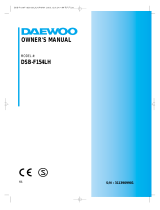If the air conditioner becomes wet, turn the power off immediately and call
your nearest contact center.
• Potential risk of fire or electric shock.
Install an exclusive circuit breaker and short-circuit breaker for the air
conditioner.
• Potential risk of electric shock or fire.
If the power cable or cord is damaged, the manufacturer, a qualified service
technician must replace it to avoid a potential risk.
Disconnect the air conditioner from power supply before it is repaired or
disassembled.
Use a receptacle that has a ground terminal. The receptacle must be used
exclusively for the air conditioner.
• Improper electrical grounding may cause electric shock or fire.
Ensure proper ground has been established when installing the air
conditioner. Do not connect the ground cable of the unit to a gas pipe, a
water pipe or a telephone line.
• Potential risk of electric shock.
CAUTION SIGNS
Ensure no water gets into the air conditioner.
• Potential risk of fire or electric shock.
Do not install the air conditioner close to heating appliances to avoid damage.
Turn off the air conditioner using the provided remote control or control
accessory (if provided). Do not unplug to turn off the unit (unless there is an
immediate danger).
Do not open the front grille during operation.
• Potential risk of electric shock or unit malfunction.
Cool air should not flow directly towards people, pets, and plants.
• It is harmful to your health, pets, and plants.
Do not run the air conditioner for an extended period of time in a room with
the door closed or with babies, elderly or disabled people.
• In case residential application, refreshing the air into the room (from external air to prevent
oxygen shortage), in order to guarantee at least 1-2 renewal/h. For different application
the renewal air has to be guarantee according to UNI 10339.
Do not use the air conditioner as a cooling precision instrument for food,
pets, plants, cosmetics or machinery.
• Potential risk of property loss.
Do not drink water from the air conditioner.
• Potential risk of health hazard.
Do not give excessive shock to the air conditioner.
• Potential risk of fire or unit malfunction.
Do not expose the dust filter to direct sunlight while drying.
• Strong direct sunlight may deform the dust filter.
Do not spray water directly on the air conditioner or use benzene, thinner or
alcohol to clean the surface of the unit.
• Potential risk of electric shock or fire.
• Potential risk of damage to the air conditioner.





















